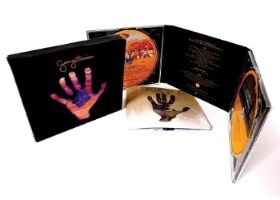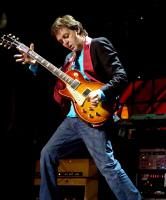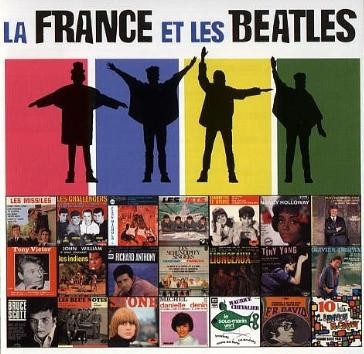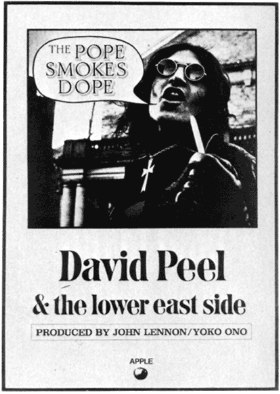© readingeagle.com, 2006
------------------------
Planned re-release of the Traveling Wilburys Volume 1
by Archer, The Mountain, 99.5 FM, Colorado
Olivia Harrison is overseeing the remastering and re-release of Traveling Wilburys material.
Olivia says George started the remastering process on Traveling Wilburys Volume 1 before his death in 2001. The first album features George, Bob Dylan, Tom Petty, Roy Orbison and Jeff Lynne.
Olivia is also involved in remastering the band's follow-up, Traveling Wilburys Volume 3, recorded after the death of Orbison.
Bonus material is expected to include the charity single "Nobody's Child," B-sides "Runaway" and "New Blue Moon (Instrumental)" plus a demo for the unfinished song, "Maxine."
The supergroup began in 1988 when George and Jeff Lynne asked Tom Petty, Bob Dylan and Roy Orbison to collaborate on a B-side for George's "When We Was Fab" single. Their first song, "Handle With Care," was taken from a sticker on a crate George spotted in Dylan's garage, where they wrote and recorded the demo.
"Handle With Care" was such a strong song, the quintet decided to secretly record an LP under the assumed surname Wilbury. On the first album, George was
Nelson Wilbury, Petty was Charlie T., Orbison went by Lefty, Dylan became Lucky and Lynne was Otis. They changed their first names for the second album.
© by Archer, The Mountain 99.5 FM, 2006
------------------------
October 19
The Beatles Love Tracklisting Announced
by
Paul Cashmere
The Beatles ‘Love’ album, the soundtrack to the Las Vegas production, will be
released on November 18th.
The album will feature new music, classic songs and experimental mixes produced
by Sir George Martin, the producer of the original Beatles albums.
The project has the full support of original Beatles Paul McCartney and Ringo
Starr as well as Yoko Ono and Olivia Harrison on behalf of the estates of John
Lennon and George Harrison.
“This album puts the Beatles back together again, because suddenly there’s John
and George with me and Ringo,” said Paul McCartney. “It’s kind of magical.”
“George and Giles did such a great job combining these tracks. It’s really
powerful for me and I even heard things I’d forgotten we’d recorded.” commented
Ringo Starr.
“The album has the feeling of love and that’s why the title is Beatles LOVE,“
added Yoko Ono Lennon, "They have let everything that is beautiful and daring
come out.”
“The music is stunning. I think the most amazing thing about it is that you can
pull it apart and all the elements carry with it the essence of the entire
song,” said Olivia Harrison.
The album will be released as both a CD and audio DVD.
The tracklisting is:
1. Because
2. Get Back
3. Glass Onion
4. Eleanor Rigby
Julia (Transition)
5. I Am The Walrus
6. I Want To Hold Your Hand
7. Drive My Car/The Word/What You’re Doing
8. Gnik Nus
9. Something
Blue Jay Way (Transition)
10. Being For The Benefit of Mr. Kite!/I Want You
(She’s So Heavy)/Helter Skelter
11. Help!
12. Blackbird/Yesterday
13. Strawberry Fields Forever
14. Within You Without You/Tomorrow Never Knows
15. Lucy in the Sky With Diamonds
16. Octopus’s Garden
17. Lady Madonna
18. Here Comes The Sun
The Inner Light (Transition)
19. Come Together/Dear Prudence
Cry Baby Cry (Transition)
20. Revolution
21. Back In The U.S.S.R.
22. While My Guitar Gently Weeps
23. A Day In The Life
24. Hey Jude
25. Sgt. Pepper’s Lonely Hearts Club Band (Reprise)
26. All You Need Is Love
© Undercover, 2006
------------------------
October 18
The Walkmen do cover version of the "Pussy Cats" album to be released on
October 24
During John Lennon's separation from Yoko Ono in
1974, he romped around LA with his buddy Harry Nilsson, getting drunk and
getting thrown out of nightclubs. In the midst of the party, Lennon, Nilsson,
Ringo Starr, Keith Moon, and a rag-tag gang of others headed into the studio
with Lennon as producer. The result was "Pussy Cats", a fascinating and often
misunderstood album featuring a mix of classics and originals rearranged by
Nilsson and Lennon to suit the wild mood of those infamous days. In January
2006, after finishing the final mix for their new record, "A Hundred Miles Off",
The Walkmen decided to recreate "Pussy Cats". After all, it's the great buddy
record of the 70's; a celebration of rock 'n' roll, good friends, alcohol, and
excessive instrumentation that's right up the Walkmen's alley. So they recruited
a team of friends to record and visually document the sessions. The limited
edition bonus DVD features a 20-minute psychedelic documentary on the making of
"Pussy Cats".
Track Listings
|
1. Many Rivers to Cross
|
|
2. Subterrannean Homesick
Blues |
|
3. Don't Forget Me
|
|
4. All My Life |
|
5. Old Forgotten Soldier
|
|
6. Save the Last Dance for Me
|
|
7. Mucho Mungo/Mr. Elga
|
|
8. Loop de Loop |
|
9. Black Sails |
|
10. Rock Around the Clock
|
|
1. In Loving Recollection: The
Making of "Pussy Cats" |
|
Official website:
The Walkmen
------------------------
October 13
"La France et les Beatles - Volume 2" is now available through Magic
Records...
Dear John,
I am particularly glad to send you the second volume of the 5 CD
series La France et les Beatles, collecting French covers of Beatles songs only
published in France between 1963 and 1971.
Several years of research have been necessary to gather these
covers and bring them to light through Martial Martinay's famous French reissue
label, Magic Records (www.magic-records.com).
All five CDs will finally represent an astounding total of more
than 100 tracks, one third of which is absolutely new to CD! And it also
constitutes the most complete collection of this kind ever published until now.
It will not only appeal to the general public, already familiar
with the names of some artists, but also to the collectors seeking for real
rarities such as the Blue Notes (Tout peut s'arranger), The Serendipity Singers
(Et je l'aime), Bruce Scott (Yesterday) or André Vasseur (Un monde sans amour)
as far as the second volume is concerned.
Every track has been carefully selected from the best possible
sources and remastered in 24 bits.
I thank you very much for your help in promoting this CD.
Yours sincerely,
Laurent Giacomelli (
laurent.giacomelli@wanadoo.fr )
PS: Volume 3 is scheduled for a mid-October release!
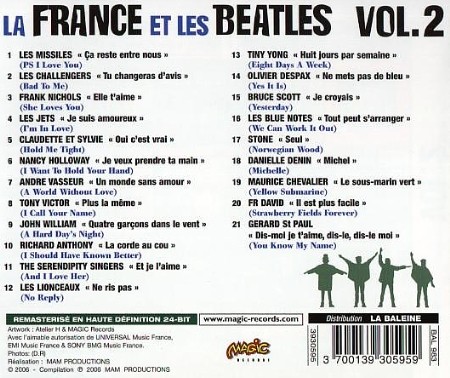

Click on the above "Magic Records" logo for more
information on the
"La France et les Beatles Vol. 2"
Quick News Picks:
Paul McCartney applies to trademark his name
(from the C.B.C. news website). And we've been waiting patiently for this
CD release featuring a guest appearance from Ringo Starr with rocker Jerry Lee Lewis: "Last
Man Standing - the Killer" (rave review);
Jerry Lee Lewis debuted at Number One on the Billboard Top
Independent Album Chart.
------------------------
October 3
My Work: Yoko Ono
by Gallery owner Deborah Colton, as told to Susan Buchanan
"I contacted Yoko Ono through L. Brandon Krall, the curator of Word, the show
currently at my gallery. The show is about the power of language to make
meaning.
"Brandon and I have worked together for about six years and she suggested Yoko's
art. The billboard is a piece Yoko Ono created in New York City after 9/11.
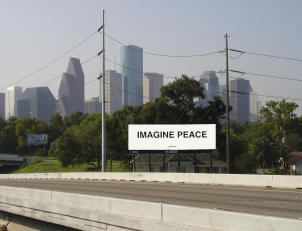 |
Imagine Peace
by Yoko Ono will be on view at the intersection of I-45 and I-10 through
Oct. 20. The billboard is part of the show Word
at Deborah Colton Gallery.
|
"We worked with CBS Outdoor to get just the right place for it because we wanted
it in a high-traffic area. We were able to rent a commercial billboard on I-45
and I-10 East going into downtown Houston, so it works with the beauty of the
downtown skyline. It's 14 feet by 48 feet, so it'll be visible to thousands of
commuters every day through Oct. 20.
"Imagine Peace speaks on so many levels: peace in your own being, peace in your
relationships or global peace. It also comes back to John Lennon's song Imagine.
It's simple but powerful. It's not confrontational, but it's about promoting
change.
"I sponsored the billboard myself because it was something I absolutely had to
do. Through my gallery I'm trying to help create a better world through art. I'm
a mother: I have a 21-year-old and a 13-year-old. I want the next generation to
have a better world."
-
Article first published: Sept. 29, 2006 and appeared on
Chrone.com
------------------------
October 2
The Beatles "Love" Album to be Released
Apple Corps Ltd/EMI Music proudly announces the release of LOVE, the new CD from
The Beatles, due November 2006.
After being asked by the remaining Beatles, Ringo and Paul along with Yoko Ono
Lennon and Olivia Harrison, to make experimental mixes from the original master
tapes for a collaboration with Cirque du Soleil, Sir George Martin, The Beatles
legendary producer, and his son Giles Martin have been working with the entire
archive of Beatles recordings to create LOVE.
The result is an unprecedented approach to the music. Using the master tapes at
EMI's Abbey Road Studios, Sir George and Giles have created a unique soundscape.
The release of this album, which is also featured in the Cirque Du Soleil/Beatles
collaborative production of the same name at the Mirage in Las Vegas, has been
much anticipated.
"This music was designed for the LOVE show in Las Vegas but in doing so we've
created a new Beatles album" said Sir George. "The Beatles always looked for
other ways of expressing themselves and this is another step forward for them."
Giles continues, "We took all the Beatles' catalogue from tape, the original
four tracks, eight tracks and two tracks and used this palette of sounds and
music to create a sound bed. What people will be hearing on the album is a new
experience, a way of re-living the whole Beatles musical lifespan in a very
condensed period".
The album will be released worldwide in November 2006. Additional information,
including a track listing will be available shortly.
Many thanks.
TheBeatles.com
-----------------------
October 1
Missing Peace: John Lennon's Legal Battles With the U.S.
By Richard Harrington
Washington Post Staff Writer
Sunday, October 1, 2006; Page N03
Was John Lennon the naive sloganeer of the '70s antiwar anthem "Give Peace a
Chance," or the troublemaker who had turned the Black Panther Party slogan into
the song "Power to the People"? Was the ex-Beatle a pro-peace dreamer who could
"Imagine" a world with no countries or religions, or the radical that the Nixon
administration saw as a threat to national security and, more importantly, to
Richard Nixon's reelection in 1972?
That was the first presidential election following the passage of the 26th
amendment to the Constitution, which lowered the voting age to 18, creating a
huge new block of voters in the key demographic of both rock music and the
movement to stop the war in Vietnam. Perhaps that's why the Federal Bureau of
Investigation and the Immigration and Naturalization Service were drafted to
"neutralize" Lennon by deporting him as an "undesirable alien" over a
misdemeanor drug conviction in England?
Lennon and Ono in a scene from the film, which revisits the musician's legal
fight to avoid deportation from the United States in the 1970s.
David Leaf and John Scheinfeld's documentary "The U.S. vs. John Lennon" revisits
a conflict that is now mostly forgotten, not least because it produced a long
legal battle that Lennon ended up winning in 1975 -- a year after Nixon had been
forced to resign over the dirty tricks of Watergate. Talk about "Instant Karma."
Or as Lennon himself put it at the time, "I believe time wounds all heels."
According to co-director Leaf, "While some know this story, to the vast audience
of people under 30, maybe under 40, John Lennon is some guy who was in the
Beatles, he wrote 'Imagine' and he was murdered -- they don't know much more
about him."
The ex-Beatle vs. Big Brother was, of course, covered widely at the time, and
Jon Wiener's 2000 book, "Gimme Some Truth: The John Lennon FBI Files,"
chronicled the UC-Irvine history professor's 15-year battle to secure those
files under the Freedom of Information Act -- a case that went all the way to
the Supreme Court. Wiener is one of many voices in the new documentary, though
the dominant ones are rightfully Lennon and Yoko Ono, the love of Lennon's life
and his co-conspirator in politically provocative, socially conscious art.
"They're co-protagonists," Leaf notes. "And they're going to get to tell their
story as to how this campaign for peace turned into a battle royal with the
Nixon administration."
That battle royal was fought on two fronts, the first in the early '70s when
Nixon miscalculated the power of an ex-Beatle (who couldn't vote) to sway the
American electorate. Perhaps Nixon was still grating about "Give Peace a
Chance." A top 15 hit, it was first commandeered in 1969 during Vietnam
Moratorium Day on the Mall, with Pete Seeger leading half a million
demonstrators in song while Nixon sat in the White House, watching a football
game. Newsweek noted, "The peace movement has found an anthem." Nixon must not
have liked that.
What really set the White House off was Lennon's appearance at a December
1971 rally for imprisoned "White Panther" John Sinclair. Speakers included Black
Panther co-founder Bobby Seale as well as several other members of the Chicago
7, charged with disrupting the 1968 Democratic convention in Chicago. When the
Michigan Supreme Court released Sinclair three days after the concert, a
paranoid White House began to view Lennon as a potential threat, particularly
after reports he was planning an anti-Nixon, get-out-the-vote tour that would
culminate at the 1972 Republican convention. That never happened and, in fact,
Lennon never toured again.
The FBI, which began its surveillance right after the Sinclair concert, closed
the Lennon file after Nixon's landslide victory over George McGovern. By then,
the far more dogged INS was on Lennon's case at the behest of Sen. Strom
Thurmond, the South Carolina Republican who suggested revoking Lennon's visa as
a "strategic countermeasure." Deportation proceedings began in February 1972,
dragged out by appeals and countersuits until Oct. 7, 1975, when a federal judge
overruled the INS. Nine months later, Lennon got his green card.
"The U.S. vs. John Lennon" uses Lennon's music, 37 of 40 tracks from his solo
career, most predating the controversy. "We're using the music as a dramatic
device," says Leaf, "to advance the story, as counterpoint or to comment on
what's going on." As in the use of "Gimme Some Truth" and its denunciation of
pro-war politicians as "short-haired yellow-bellied son of Tricky Dick" over
scenes of the Watergate hearings, which Lennon and Ono attended during one of
their frequent Washington visits.
The utopian anthems -- "Give Peace a Chance," "Power to the People," "Imagine,"
"Happy Xmas (War Is Over)" -- have proved lasting, as well as popular. But when
Lennon wrote political material ("John Sinclair," "Attica State," 1972's
"Sometime in New York City" album), the results were often awful, as well as
uncommercial.
All the White House had to do was "look at the charts and see that people
weren't buying overt political messages from John," says Leaf. "They were buying
'Imagine,' but not the more strident material."
In fact, Lennon never seemed particularly comfortable in the role, admitting
that "being political interfered with my music." "I'm an artist first and a
politician second," he told Dick Cavett, amending that in Rolling Stone to "I'm
a musician first, not a politician."
By the time Lennon got his green card, he'd withdrawn from the public eye. "I
think it's fair to say that this experience exhausted him," says Scheinfeld,
"and by 1975 he was feeling the need to get some balance in his life."
Lennon would return with "Double Fantasy" in 1980, the year he was killed, and
the album's paeans to fatherhood and married life. In a handful of interviews
done not long before his death, the ex-Beatle distanced himself from his '70s
political activities, staying on point with just one issue: "Our duty or our
position was to keep on about peace until something happened, you know, and it
was in the tradition of Gandhi, only with a sense of humor."
He'd said much the same thing at the 1971 Sinclair rally that started his
troubles: "Apathy isn't it. . . . Okay, so flower power didn't work; so what? We
start again."
© The Washington Post 2006
